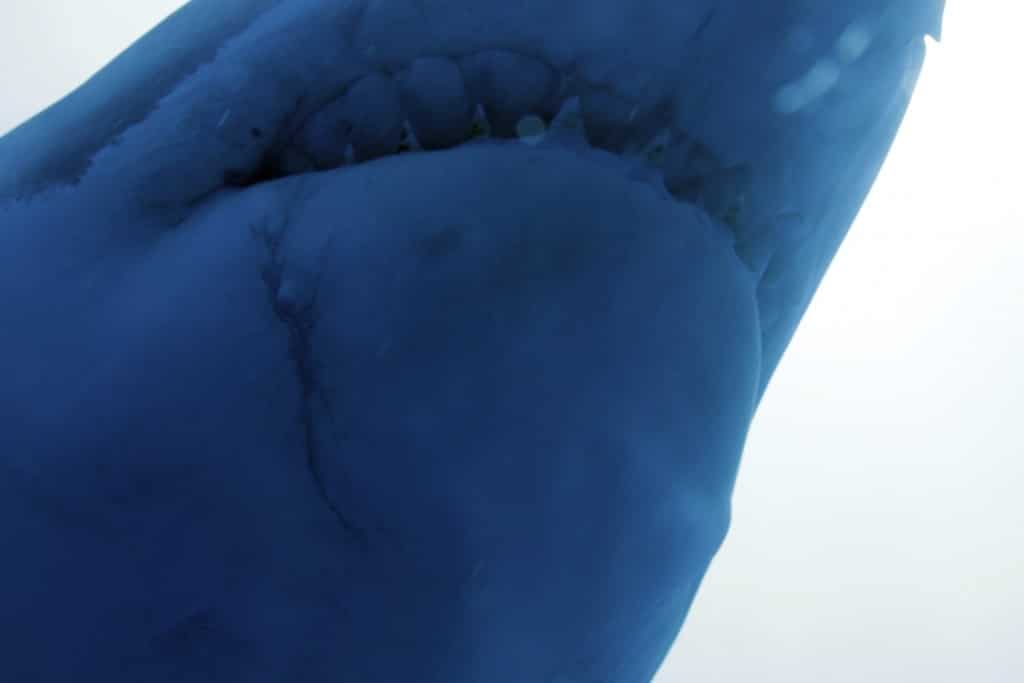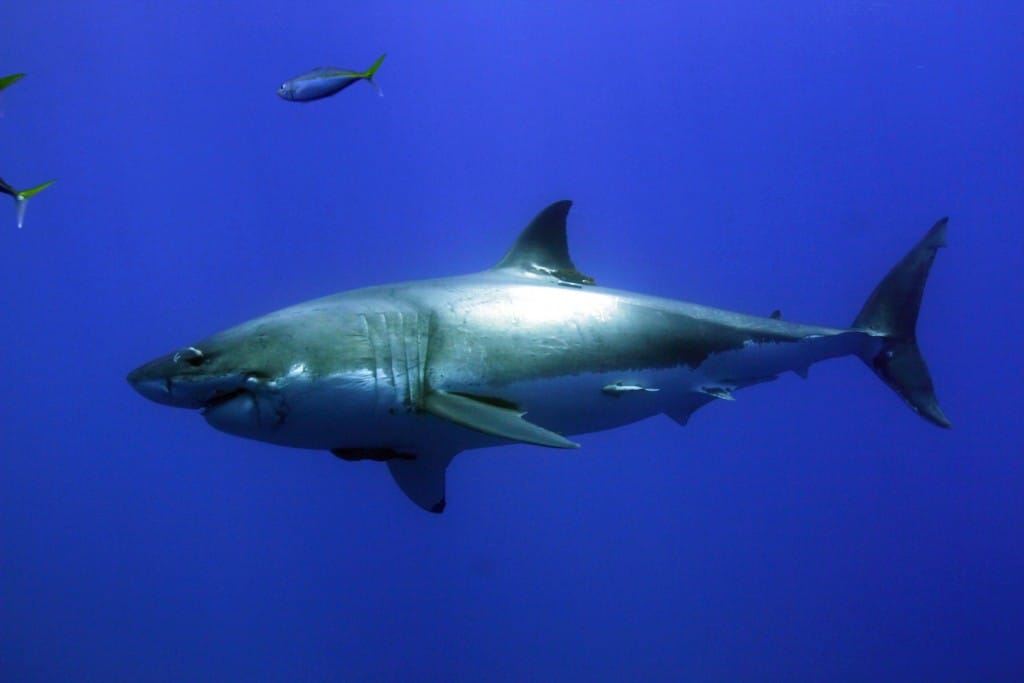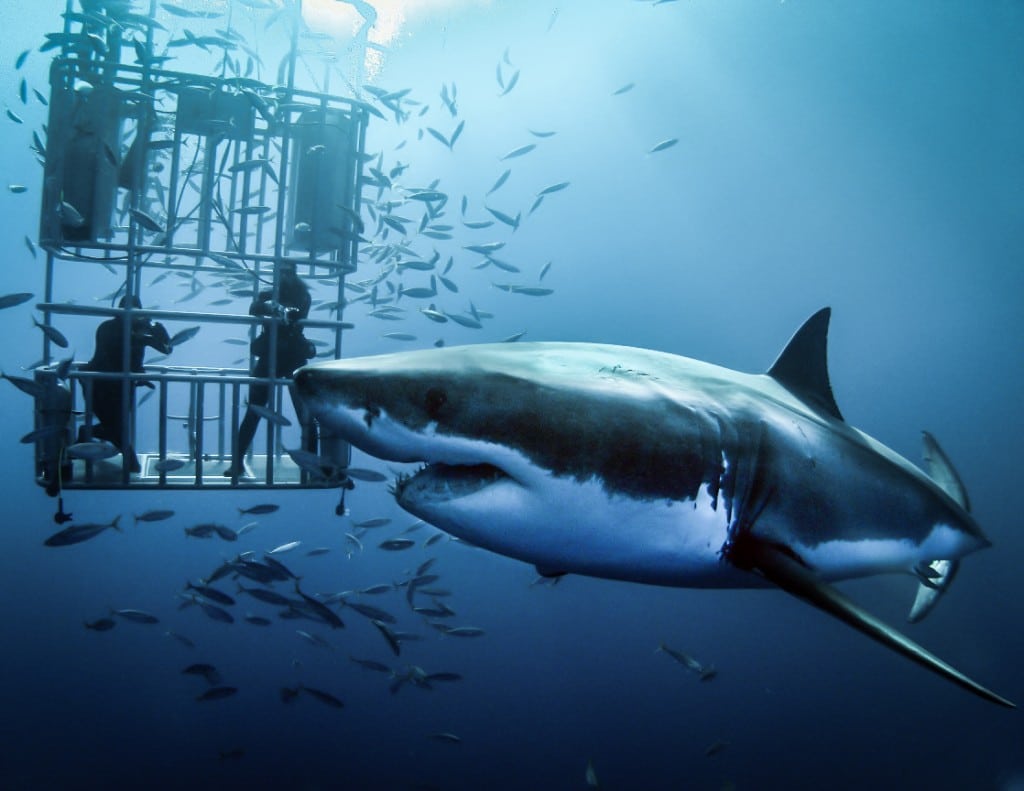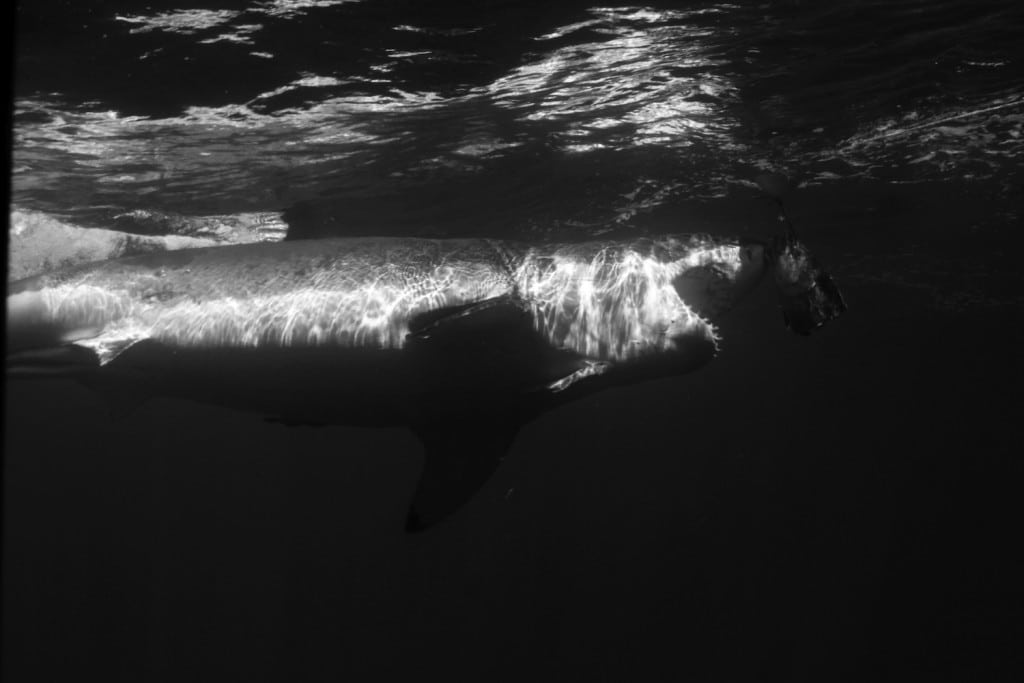News
The Origin and Development of Cage Diving with White Sharks: Part 1

“Sharks are eating machines, and nobody’s told them not to eat us.” Rodney Fox
Last October it happened again: A video showed how a white shark broke through the bars of a shark cage in front of the Mexican island of Guadalupe. A horror for the diver – but also the shark itself. The animal rammed the metal construction and got into it. Helplessly, the crew watched as the shark panted and freaked out in the cage. They opened the lid of the cage in the hope that it would get out again. It took about 50 seconds until it was clear that the diver was not injured. The most battered was the shark himself, who, after panicking tried to get out of the cage. It was hurt and swam away bleeding.

If you are doing some internet research, you will find around half a dozen similar cases. Headlines such as “shark breaks through cage diving rods” or “divers in danger of life: white shark penetrates into cage” rule the gazette and tabloid papers. For years there has been a great controversy between animal protectionists and divers on the subject of cage diving. Some consider it to be irresponsible and demand an immediate stop of these excursions because the hunting instinct of the white sharks are triggered when fed with bait. They would become aggressive and lose their timidity against people.
Many suspect a connection with the increasing attacks on swimmers and surfers off the coast of South Africa. In 2009 and 2010 alone, 14 incidents were recorded, six people died. However, advocates of cage diving claim that sharks are not fed at all, but only attracted and lured to the boat with chum and believe that through this kind of encounter people recognize the white shark’s value as protective creatures.

A closer look at the history of cage diving…
It’s a strange thing with white sharks. While many scuba divers cannot get enough white sharks in front of their masks, most other people are happy when they never see one. The (wrong) picture of the beast lies too deep in our minds, about the killer with the jagged teeth. Something peculiarly sinister. It’s an eerie feeling to suddenly be part of the food chain when you enter the ocean. You could be human prey and end up in a monster’s stomach.
“What is a monster? To a mouse, a cat is a monster. We are just used to being the cat.” This classic line from the movie “Jurassic World” shows the myths of antiquity when thinking about big predators. Some divers are concerned less about their lives when it comes to white sharks, but rather about how they can at least see some of the elegant predators? The answer is – doing cage diving!

20 years ago, cage diving was reserved for daredevils and experienced divers. Nowadays, thanks to increased regulations and safety measures, almost anyone and even children can indulge this adrenaline “kick”. You do not even need scuba diving training. Eye to eye with a white shark – for many it is on their bucket list. That is why cage diving has now become a multi-million-dollar business. There are only four places in the world where you can pursue this thrill: the most famous are South Africa (False Bay and Gansbay) and South Australia (Neptune Islands near Port Lincoln). In California, you have the Farallon Islands and relatively new is the opportunity in New Zealand, at Stewart Island in the very south. The reason: in these places, there are large seal colonies, the main prey of the white sharks.
Australia – How it all began
No, for once it did not start with Richard Dreyfuss as Matt Hooper and his jump into the cage in “Jaws”. Cage diving started in the late 60s, around Dangerous Reef and other places in the South Australian Spencer Gulf. Experienced divers like Ron and Valerie Taylor, or Rodney Fox, made their first attempts at cage diving. They benefited from South Australian fishermen, such as Alf Dean, who had developed techniques to lure white sharks to their boats.
One of the most famous and widely discussed shark incidents of all time, is the attack on Rodney Fox: This attack took place on December 8, 1963, at Aldinga Beach, about 50 km south of Adelaide. This incident became so popular because Fox was the first person to survive a white shark attack and talk about it later. The doctors needed 462 stitches to sew him together and save his life. Fox then came up with an idea:
“My wife and I were at the zoo and we watched lions and tigers behind bars. The thought came to me: Perhaps one can also observe sharks from a cage. Around 1965 I organized an expedition with two other shark attack victims, to observe white sharks. The animals were more interested in the bait than in us. When I was in the water with those apex predators, I became aware that I no longer wanted to be an insurance agent. So, I quit my job, started to collect abalone mussels and offer white shark trips.”

Rodney made plans and then built the first two-man cage. He organized a new boat and found sponsors for the shark expedition. With guests, shark attack victims Brian Rodger and Henri Bource, Rodney called Ron Taylor to film the expedition in partnership with him. This was the first time that great white sharks were filmed under water. It was a turning point in the life of Rodney Fox. He discovered that white sharks were not crazy about human flesh, but fascinating and cautious creatures. Rodney, Ron and Valerie’s film “Blue Water, White Death” was a great success and was shown in 1971 in many countries around the world. During the shooting, large “gorilla cages” made of steel were used. This was safe, but also very time-consuming and therefore cost several thousand dollars.
“Then I received this incredible call from Hollywood to see if I could help the film crew with real shark footage for ‘Jaws’. At this time, we had no idea that this movie would give the shark such a bad image. The film crew visited me in Port Lincoln, where I lived. In addition, one of the screenplay authors came, Carl Gottlieb. They gave me their storybook and showed me what they needed. We filmed the white sharks in the next days from the right, from the left, from the top from below.”
In 1976, shortly after “Jaws” was published, Rodney received a request from an American dive company who wanted to bring their customers on a shark expedition. Rodney was happy, and it was the world’s first cage diving tour – the first of many, as it turned out. Thereupon the Taylors developed light-floating cages, which were more suitable for film purposes than the heavier ones used in commercial cage dive trips. The Taylors had found that heavy cages were unnecessary because sharks usually swam around the cages and did not even try to penetrate the cage. The result were light wire mesh cages with galvanized steel frames, side doors and deck flaps.

South Africa
In South Africa, cage diving is of younger origin and was only practiced sporadically in the western Cape Province around Struis Bay (east of Cape Agulhas) and in False Bay near Cape Town in the late 1980s. In 1997, seven commercial cage dive operators finally entered the Dyer Island Channel at Gansbay. Among them, hard and aggressive competition developed, which also disturbed research, seal and bird colonies. The events finally culminated in threats and trials between individual groups, as more and more funds for films and ecotourism flowed to Gansbay and led to a “cowboy mentality”. Ironically, scientific organizations have received less and less research funding for the white shark research at Dyer Island and elsewhere, while commercial cages and travel agencies have made a fortune with the increasing flood of people who wanted to see and film white sharks.
Personal experiences
The “Apex Predator”, “The Ultimate Killing Machine”, “The Perfect Hunter” – when talking about white sharks, superlatives are fast at hand. In every children’s card game it would be the trump card: the world’s biggest predator fish, the white shark. They are usually between four and five meters long and can reach a maximum of six meters and weigh more than two tons. I also wanted to see this animal “live”.

In 2001, I applied to the White Shark Research Institute in Gansbay/South Africa as a student field assistant and was accepted. For three weeks, I could work with the world-famous shark expert Craig Ferreira. Craig was one of the driving forces in a lobby that led to the protection of the white sharks in South Africa in 1991. It was hard to believe that his father Theo was once a notorious hunter who later became an environmentalist.
Even today, the story about Theo Ferreira and his hunt for a notorious shark, which they only called “the Submarine” is still being told. This white shark, was said to be as big as a submarine, supposedly seven meters in length and five tons in weight. Theo harpooned him three times, but he could escape again and again. Craig later transformed the adventurous hunt into a fictional story in his novel ‘The Shark’.
Of course, Craig also told me all about the biology, reproduction, and behaviors of the sharks themselves. The institute owned two boats, the “Elasmo I” with twelve meters in length and the “Elasmo II” with nine meters in length. Each boat had a cage. To my great surprise, these were not heavy steel cages, as I knew from the documentary “Blue Water, White Death,” but simple two-man cages made of wire mesh fence, reinforced only by steel struts.
Also, the brochure with the “Cage Emergency Procedures”, was not very encouraging to me if something went wrong. I was a little nervous when I read: “Broken Air Line”, “Drifting Cage”, “Shark Entangled and Air Line Cut”. I was ready to leave. But that was only in case of emergency, Craig said with a broad grin on his face. If I had once believed where sharks are found, you only had to hold your bleeding finger in the water and they will promptly tear off your arm, I was now taught something better…

Our boat was anchored in front of Seal Island, 5 Kilometers from shore. We dumped liters of chum into the water (mashed up sardines). The minutes went by but nothing happened – nothing at all! No sharks far and wide. It almost seemed to me that the seals were laughing at me with their staccato-like howling. “If a white shark was swimming here, we wouldn’t be in the water, fool” they seemed to tell me. The waves were unrelenting on our boat, I tried to keep my balance. Although the nausea was getting worse, I was pumped with adrenaline, my eyes continuously scanned the water surface for the infamous dorsal fin.
Craig fastened two huge tuna-heads on a rope and threw them into the water. “The bait leads the sharks to the boat and makes sure they stay here for a while. When a shark wants to catch the tuna bait, I pull it away and lure it ever closer to the boat so we can study it well. As if you were attracting a donkey with a carrot”, Craig said. “It’s about keeping the shark by the boat, not feeding them with the bait. Because they should not link boats and humans with prey”, the expert said.
And then, after an hour or so, they came: first one, then two, then three and four. White sharks circled our boat, I could hardly believe my luck! Gracefully their dorsal fins cut through the water surface, their torpedo-shaped bodies were simply enormous. These sharks were between three and four meters long, so just a good average for a white shark. But it is not the pure length, which takes one’s breath away, but above all it’s the girth. If you have never seen a shark in reality, let me tell you that sharks are not thin, slender fish, such as barracuda. Their bodies are massive and conical at the same time, their chest fins act like huge wings of a jet fighter!

The water was greenish and murky. Because of the bad visibility it was difficult for me to keep the individual animals apart. But after another hour, Craig told me that ten different sharks were swimming around our boat – ten! And the most fascinating thing was that they were not at all aggressive. Rather curiously and carefully they approached the bait, snapped here and there for a tuna and dived leisurely. I understood quite quickly – these sharks were no brainless killer machines from the cinema, but highly developed, perfectly adapted predators.
False Bay
In 2010, I repeated my trip to South Africa, but this time I visited shark researcher Chris Fallows in False Bay. His TV documentaries ‘Air Jaws’, about the breaching white sharks are world famous. With his boat “Apex Predator” we went to Seal Island. We anchored nearly 100 meters from the island, the seals howled on the rocks, the wind rushed around my ears – it was a hellish noise. But it was a beautiful day with sunshine and calm sea, numerous seals swimming around in the water.
I just pulled the neoprene suit up to get into the cage, as the water exploded not far from the boat: a white spray fountain exploded into the air. I finally witnessed a white shark catapulting itself out of the sea to catch a seal. He jumped in complete silence and brought the total destruction on impact – a natural force that manifested itself as strong and invisible as a storm! The seal had no chance.
On this trip, I could deepen my studies and I was surprised to find some news: Chris did not use a chum to lure the sharks. “We have found that the sharks are here anyway and we do not need blood to lure the animals to our boat. A few tuna-baits and our seal decoy are completely sufficient”, he told me.

During this trip, we had eleven white sharks around our boat, the largest measured roughly more than 4 meters. And the cages had changed a lot: now there were long steel cages with space for at least four to six people, which were attached to the boat. There were no diving bottles or air hoses – when a shark approached the cage, we just dived down with the air in our lungs for a few seconds. So, you did not need a divers licence – just a little courage.
Not only in Gansbay and False Bay there are large seal colonies, but also in Mossel Bay, some 400 kilometers further east. Here you can also find a large rock with a seal population of around 3,000 animals. While in the first two locations the islands are located about five kilometers from the mainland, the seals in Mossel Bay are only 800 meters from the beach – very close to swimmers and surfers! It could be assumed that there are many attacks on humans – but the opposite is the case. The only deadly attack took place in the vicinity on 29 August 2009 on surfer Gerhard van Zyl. His right lower leg was bitten off, he died a little later from the blood loss in hospital.
The seal colony is largely left alone by the sharks. As a reason, Fallows suspects that the white sharks in Mossel Bay are subadult animals up to a maximum of three meters in length. They hunt mainly fish and are not yet big enough to kill seals. Therefore, Mossel Bay is a kind of “training camp” for the sharks. Once they have learned to sneak and chase here, they swim further south to Gansbay and False Bay.
Christian’s story continues in Part 2 tomorrow… as he travels to Guadalupe, Mexico and asks whether the cage industry and ‘shark tourism’ have any benefit for sharks. Check back tomorrow!
All photos by Christian Kemper unless otherwise stated.
 You can purchase Christian’s book, ‘Strange Pool Friends – Mein Freund, der Hai’, here.
You can purchase Christian’s book, ‘Strange Pool Friends – Mein Freund, der Hai’, here.
Blogs
Discover Curaçao with the Ultimate Dive Vacation Guide – 2024 DEMA Special Edition

Dive Travel Curaçao is thrilled to announce the launch of the Curaçao Dive Vacation Guide – 2024 DEMA Special Edition, an expertly curated resource that unveils the unparalleled dive experiences and vacation possibilities awaiting you in Curaçao. Produced exclusively for the Diving Equipment & Marketing Association (DEMA) Show 2024, this special edition guide is packed with exclusive insights, travel tips, and limited-time DEMA offers that make it easier than ever to explore Curaçao’s stunning underwater landscapes and vibrant culture.
Explore Curaçao’s Unmatched Diving Opportunities
With over 70 diverse dive sites along its southern coastline, Curaçao is a bucket-list destination for divers of all experience levels. From thriving coral reefs and intricate marine ecosystems to historic shipwrecks, the island offers a variety of underwater experiences that are hard to match. The Curaçao Dive Vacation Guide – 2024 DEMA Special Edition provides detailed recommendations for both shore and boat diving, making it a valuable tool for divers seeking the best entry points, pristine reefs, and hidden treasures along the coastline. Whether you are an avid wreck diver, or a beginner interested in shallow reefs, Curaçao has it all.

Uncover Eco-Friendly Dive Resorts and Top Dive Operators
This DEMA 2024-exclusive Curaçao guide goes beyond diving to feature insider information on Curaçao’s eco-friendly accommodations, dive resorts, and top-rated dive operators committed to sustainable dive tourism. From all-inclusive resorts that support coral reef restoration initiatives to charming boutique hotels near prime dive locations, the guide helps travelers find the ideal stay to match their vacation goals. It also spotlights trusted dive operators on the island who prioritize environmental preservation, offering travelers a way to enjoy the underwater world responsibly.

Immerse Yourself in Curaçao’s Culture, Culinary Delights, and Adventure
Curaçao offers a vibrant Caribbean culture rich in history, music, and culinary fusion. The guide reveals Curaçao’s hidden gems, including culinary hotspots, historical sites, and eco-tourism opportunities that will appeal to both divers and non-divers. Visitors can explore the island’s iconic architecture, savor a diverse range of dishes influenced by Caribbean, European, and South American flavors, and embark on land-based eco-adventures, such as hiking, cave exploration, and visiting national parks.

Exclusive DEMA 2024 Specials and Limited-Time Dive Packages
This special edition guide features limited-time DEMA 2024 offers on dive packages, accommodations, and excursions. Travelers who book through Dive Travel Curaçao, or our Curaçao dive travel partners attending DEMA, will have access to exclusive discounts on custom dive vacation packages, making it easier to plan an affordable, high-quality dive trip that fits your preferences. The Curaçao Dive Vacation Guide – 2024 DEMA Special Edition is designed to simplify your travel planning and help you dive deeper into the incredible experiences that Curaçao has to offer.
It’s Time to Dive Curaçao!
Now is the time to discover why Curaçao is a top dive destination in the Caribbean! Dive Travel Curaçao invites you to experience an unforgettable dive vacation with exclusive DEMA 2024 specials tailored just for you. To secure your spot, download a copy of the Curaçao Dive Vacation Guide – 2024 DEMA Special Edition and contact the Dive Travel Curaçao team to start customizing your Caribbean dive adventure today.
For more information and bookings, please visit Dive Curaçao’s website or contact our reservations team directly.

News
Santa Divers take the Plunge for Charity

Ho Ho Ho! Vobster Quay’s recording-breaking charity Santa diving event returns on Sunday 15th December 2024 for another round of festive fundraising frivolities. Run in aid of the Royal National Lifeboat Institution (RNLI) and Help For Heroes, this ever-popular annual fundraising event aims to raise sack-loads of cash for these two very deserving charities.
Divers of all levels are invited to grab their Santa outfits – and as much festive cheer as they can muster – and head down to Vobster Quay near Mells, Somerset for a mass sponsored Santa dive in aid of charity. In previous years, the event has attracted divers from the far corners of the UK to join in the festive merriment for a final festive dive before the Christmas and New Year break. Back in 2015, the event smashed the world record for the most Santa divers with 188 divers taking to the waters donning their festive finery – a record that remains unbeaten to this day!

Vobster Santas isn’t just about setting records – it’s also about raising some serious cash for charity. Vobster Quay encourages all divers to get into the spirit of the season to raise much-needed funds for two very deserving charities – the Royal National Lifeboat Institution (RNLI) and Help For Heroes.
Through individual sponsorship and online donations, divers can invite their friends, family and work colleagues to sponsor them to plunge into the balmy waters of Vobster Quay dressed in full festive finery. Since the very first Santa dive in 2007, the event has raised over £52,000 for charity. “It’s been over 17 years since the very first charity Santa dive took place at Vobster Quay and every year the event just keeps getting bigger and better” enthused Vobster Quay owner, Amy Stanton.
“Vobster Santas is a great way for divers to say a massive thank you to the both the RNLI and Help For Heroes – two very deserving charities close to our hearts. We’re immensely proud of all that Vobster Santas has achieved and hope that even more divers will join this year’s event on Sunday 15th December. I’m confident that we can make Vobster Santas 2024 the biggest yet!”.
Divers wishing to participate can get involved by simply registering their attendance at
www.vobster.com/event-vobstersantas.php.

-

 News1 month ago
News1 month agoIconic SS United States to become the World’s Largest Artificial Reef
-

 Blogs3 months ago
Blogs3 months agoNovoScuba’s Game-Changing Approach for Dive Store Owners: WE PAY YOU!
-

 News2 months ago
News2 months agoBook Review – 52 Assignments: Underwater Photography
-

 Gear News2 months ago
Gear News2 months agoDYNAMICNORD – New German diving brand enters the British market
-

 News2 months ago
News2 months agoExploring Cenote El Pit: A Diver’s Dream
-

 Gear News2 months ago
Gear News2 months agoTry BARE drysuits (and maybe even win one!) this Friday with Sea & Sea at North West Dive Fest
-

 News3 months ago
News3 months agoComing Soon – 52 Assignments
-

 News3 months ago
News3 months agoSave £200 per person per week at Pole Pole Lodge with Dive Worldwide













